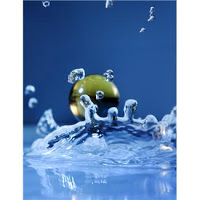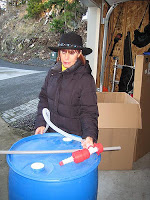Gaye Levy, Contributing Writer
Activist Post
When I first started Backdoor Survival, my focus was on gathering the basics: food, water shelter and fire. Or course, along the way I have learned that there is so much more that is essential to long term survival. Things that come to mind are clean air, clothing, first aid, self-defense, signaling and contact with others.
But today I want to keep things simple and, for the benefit of my newer readers, go back the basics and review the essentials of water for survival.
Water – The Most Important Survival Basic
Clean water is something that we all take for granted. We turn on the faucet and there it is. It is plentiful, it is clean and it is drinkable. Yes, it may have some undesirable chemical additions (fluorides come to mind) but that is a subject for another day. So if a disaster occurred and the supply lines to fresh water were comprised, we would be in a pickle. There is a possibility that safe water would not be available for days and possibly not for weeks.
For this reason, the American Red Cross, FEMA, and just about every other authority out there recommends that the public store at least one gallon of water per person, per day for a minimum of three days. But if you think that a three day water supply is adequate, think again.
A more reasonable recommendation is that you up the recommended amount of stored water to a two week supply. So for two people that would be 2 people x 1 gallon x 14 days = 28 gallons. This amount should cover your minimal needs for drinking, food preparation and nominal – and I mean nominal – hygiene.
Water Storage
Storing water for an emergency can be as simple as filling thoroughly washed plastic or glass containers with tap water and sealing them tightly. This is something that anyone can do without incurring a cost so long as few simple rules are followed.
So let’s do it. Let us store some water following these steps:
-
Clean them up. Thoroughly clean your plastic bottle and jugs with dishwashing soap and water then rinse completely so there is no residual soap.
-
Sanitize with bleach. Sanitize your bottles by adding a solution of 1 teaspoon of on-scented liquid household chlorine bleach to a quart of water. Swish the sanitizing solution in the containers so that it touches all interior surfaces. Don’t forget to sanitize the lids and caps as well. After sanitizing the containers and caps, thoroughly rinse out the bleach solution with clean water.
-
Fill ‘em up. Fill them to the top with regular tap water. Add two drops of non-scented liquid household chlorine bleach to the water, then tightly close the containers using the original caps. It is probably a good idea to use some latex or nitrile gloves at this point so that you maintain the sanitation and do not contaminate the caps by touching the inside of them with your fingers.
-
Date the outside with a permanent marker such as a Sharpie .
-
Store in a cool, dark place.
-
Important: rotate in six months. Dump the water, re-sanitize the jugs, and start all over. Personally, I think it would be a good idea to put up a few jugs at the first of each month. Do this for six months and you will build up a nice, rotating stock.
Plastic soda bottles or juice jugs work well for this purpose.
Water stored this way is good for six months to a year as long as it is kept in a cool, dark place. Regardless of where it is kept, the containers should be rotated at the end of the designated period.
Note: Milk jugs should not be used since the milk and protein sugars are difficult to remove and will compromise the stored water because this will provide an environment for bacteria growth. In addition, milk jugs are flimsy and will not hold up, even for a short period of time. Ditto cardboard. The cardboard will eventually leak and make a big mess. Glass is okay but be aware that glass is heavy and subject to breakage.
If you have the space and the budget, you can purchase food-grade plastic drums designed for water storage. These typically hold 55 gallons of water and with the addition of proper purification chemicals, will keep the water safe for up to five years. I personally have a 55 gallon water storage system. It was easy to set up and it came outfitted as a complete kit with all of the various tools and siphons I will need if/when that emergency situation occurs.
Another alternative, of course, is bottled water. The same rule applies: store in a cool, dark area and periodically rotate.
Hidden Sources of Water
In addition to tap water, there are other hidden sources of water that you can use when a disaster occurs. These sources include the water in your hot water heater, pipes, and even the ice cubes from the icemaker in your refrigerator or freezer. Before tapping in to these sources, however, you will first need to shut off the main valve coming in to your home so that you do not contaminate the ”good” water with the “bad”.
Here are some specific instructions for using the water in your hot water tank:
- Turn off the electricity of gas.
- Open the drain at the bottom of the tank.
- Start the water flowing by turning off the water intake valve at the tank and turning on a hot-water faucet.
- And don’t forget: be sure to refill the tank before turning the gas or electricity back on.
Outdoor Sources of Water
Barring the use of stored water or the hidden water sources in your home, there is always the outdoors. Water may be available from rainwater, streams, ponds, lakes and natural streams. But absolutely stay away from flood water since it is likely to contain sewage and other nasties that you do not even want to think about.
When using outdoor sources of water, you are going to have to undertake purification measures to make it safe. There are many ways to purify water, some better than others and some easier than others.
Water Purification
For ad hoc water purification, nothing beats plain old Clorox as long as it is fresh (no more than a year old) and unscented.
According to the Clorox website: When boiling off water for 1 minute is not possible in an emergency situation, you can disinfect your drinking water with Clorox® Regular-Bleach as follows:
-
Remove suspended particles by filtering or letting particles settle to the bottom.
-
Pour off clear water into a clean container.
-
Add 8 drops of Clorox® Regular-Bleach (not scented or Clorox® Plus® bleaches) to one gallon of water (2 drops to 1 quart). For cloudy water, use 16 drops per gallon of water (4 drops to 1 quart).
Boiling water is considered the safest method of purifying water. What you do is bring water to a rolling boil for three to five minutes. The water may not taste that great but it will be safe to drink.
Factoid: To improve the taste of boiled or stored water, you can put some oxygen back in to the water by pouring it back and forth between two containers.
As an alternative to bleach or boiling water, the EPA has guidelines for using calcium hypochlorite, common sold as “pool shock” to disinfect water:
Add and dissolve one heaping teaspoon of high-test granular calcium hypochlorite (approximately ¼ ounce) for each two gallons of water, or 5 milliliters (approximately 7 grams) per 7.5 liters of water.
The mixture will produce a stock chlorine solution of approximately 500 milligrams per liter, since the calcium hypochlorite has available chlorine equal to 70 percent of its weight. To disinfect water, add the chlorine solution in the ratio of one part of chlorine solution to each 100 parts of water to be treated.
This is roughly equal to adding 1 pint (16 ounces) of stock chlorine to each 12.5 gallons of water or (approximately ½ liter to 50 liters of water) to be disinfected. To remove any objectionable chlorine odor, aerate the disinfected water by pouring it back and forth from one clean container to another.
A good reference for this and other purification methods can be found in the downloadable and printable article Emergency Disinfection of Drinking Water.
What About Water Filters
 The use of water filters to make raw water drinkable is another solution to the water for survival dilemma. The nice thing about a filtration system is that it will not only supplement your stored water, but will provide you with great tasting, chemical free drinking water for day to day. I personally have a Royal Berkey and to tell the truth, wonder what took me so long to discover this alternative to purchased water in bottles and a countertop Brita.
The use of water filters to make raw water drinkable is another solution to the water for survival dilemma. The nice thing about a filtration system is that it will not only supplement your stored water, but will provide you with great tasting, chemical free drinking water for day to day. I personally have a Royal Berkey and to tell the truth, wonder what took me so long to discover this alternative to purchased water in bottles and a countertop Brita.
This is not to say that I don’t have bottled water because I do. After all, if I have to leave my home it would be tough to drag along a 55 gallon water barrel or a Berkey. But for day to day drinking as well as long term survival needs, you simply can not beat a quality filtration system.
The Final Word
Thanks to a tip from one of my readers, I learned that you can find pre-used, food grade plastic drums on Craigslist for about $25 each. If you decide to check in to this, be sure to confirm that the original contents was food then clean them well first with vinegar and baking soda to remove odors and then with bleach for sanitation.
Here in my area, there is a fellow that sells such barrels and will even add a hose bib at the bottom for a nominal cost. I am not 100% sure I would drink from such a barrel but the water inside should be great for bathing, laundry and housekeeping chores.
Another reader has suggested the use of colloidal silver to get rid of bacteria in water. I have not researched this personally, however.
Whatever your water storage method of choice, I highly recommend that you store at least two weeks of water for every member of your household. Just remember, you can survive an average of three to five days without the intake of water. Why take a chance?
Read other articles by Gaye Levy here.
Enjoy your next adventure through common sense and thoughtful preparation!
Gaye Levy, the SurvivalWoman, grew up and attended school in the Greater Seattle area. After spending many years as an executive in the software industry, she started a specialized accounting practice offering contract CFO work to emerging high tech and service industries. She has now abandoned city life and moved to a serenely beautiful rural area on an island in NW Washington State. She lives and teaches the principles of a sustainable, self-reliant and stylish lifestyle through emergency preparation and disaster planning through her website at BackdoorSurvival.com. SurvivalWoman speaks her mind and delivers her message with optimism and grace, regardless of mayhem swirling around us.
linkwithin_text=’Related Articles:’




Be the first to comment on "Back to the Basics: Water for Survival"